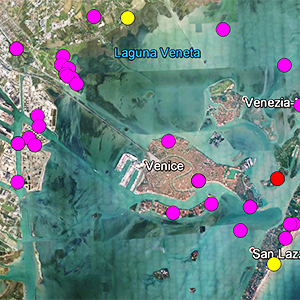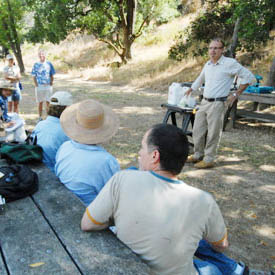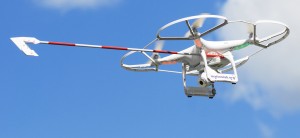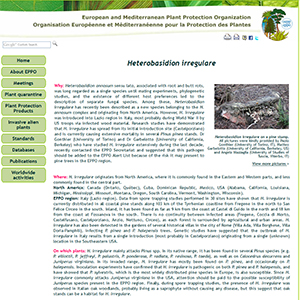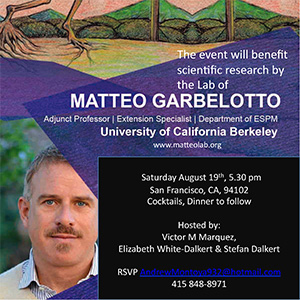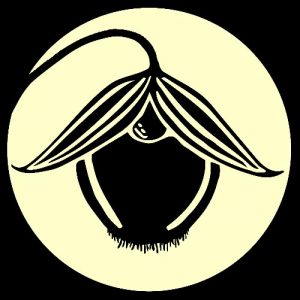Ecology & Impacts of Emergent Forest Diseases in California
For Class Primary Zoom Link – In the event of stream failure use the Alternate Zoom Link code: 586155
Class Schedule & Other Important details
This class will have a unique schedule. Class is offered two Thursdays and a weekend. Class times are:
- Thursday, April 4th 3-5pm on Zoom. Zoom link. Login to berkeley.zoom.us first, then join class zoom
- Saturday, April 6th. In person Hearst Field Annex Room B1 (HFAXB1) 8.30 am sharp to 5 pm. Lunch break: 12:10-1:15
- Sunday, April 7th. In person Hearst Field Annex Room B5 (HFAXB5) 8.30 am sharp to 5 pm. Lunch break: 12:10-1:15
- Thursday, April 11th 3-5pm on Zoom. Zoom link. Login to berkeley.zoom.us first, then join class zoom
Optional:
- Thursday, April 18th 3-5pm on Zoom. Zoom link Review of Class. Login to berkeley.zoom.us first, then join class zoom
- Thursday, April 25th 3-5 pm on Zoom. Zoom link Office hours. Login to berkeley.zoom.us first, then join class zoom
Given the short nature of the course you may take the final exam twice, if you wish to do so. Exams are online and will not be identical, but of course will cover the same topics. The best grade between the two will count as the base of your final grade. You can improve your final grade by one step by writing a 3 to 5-page paper on one of the topics listed on the website.
- 1st Final, Thursday May 2nd, 6pm-9pm (exam time is two hours). Location of your choice.
- 2nd Final, Friday May 10th, 7pm-10pm (exam time is two hours). Location of your choice.
Course Organization
The course is organized in 10 parts:
- Part1: Introduction to tree diseases and their causal agents.
- Part2: Tree diseases caused by parasitic plants, bacteria, phytoplasmas viruses and nematodes.
- Part3: Fungi and oomycetes as pathogens. How can we categorize diseases?
- Part4: Ecology of forest diseases, differences between native and non-native diseases.
- Part5: Introduction pathways, mechanisms of invasion, and control strategies of emergent forest pathogens: Sudden Oak Death, soilborne Phytophthoras , Phytophthora cinnamomi and Heterobasidion Root Disease.
- Part6: Novel, large-scale tree mortality in California is caused by latent pathogens triggered by climate change.
- Part7: Fungal Invasions: beyond the Lack-of Co-evolution Hypothesis: The Cypress Canker Disease and Heterobasidion irregulare examples.
- Part8: Two models for introduced diseases in California: White Pine Blister Rust and Dutch Elm disease.
- Part9: Walking Field trip and Lab diagnostics. Campus Tour Map – Google Map – JPG
- Part10: Pitch Canker Disease and 1000 Canker Disease of Walnuts.
Readings
10 Required Readings for the 10 parts of the course
- Part1: Cobb2017: Tree diseases as a cause and consequence of interacting forest disturbances
- Part2: Almeida2015: How Do Plant Diseases Caused by Xylella fastidiosa Emerge?
- Part3: Fisher2012: The Fear of Fungi
- Part4: Gilbert2002: Evolutionary ecology of plant diseases in natural ecosystems.
- Part5: Hayden2012: Sudden oak death: interactions of the exotic oomycete Phytophthora ramorum with naïve North American hosts.
- Part6: Hennon2020: A framework to evaluate climate effects on forest tree diseases
- Part7: Garbelotto2022: Ecological, evolutionary, and societal impacts of invasions by emergent forest pathogens.
- Part8: Dudney 2021: Nonlinear shifts in infectious rust disease due to climate change
- Part9: Luchi2020: Fast and reliable molecular methods to detect fungal pathogens in woody plants
- Part10: Onufrak2020: Regional Differences in the Structure of Juglans nigra Phytobiome Reflect Geographical Differences in Thousand Cankers Disease Severity.
Supporting Course Readings
- Simons2021: Disease out break appears to be killing bay area trees.
- Serrano2019: A microsatellite analysis identifies global pathways of movement of Phytophthora cinnamomi
- Garbelotto2021: Feral Atlas – Will Emergent Diseases Decimate Our Forests?
- Swiecki2018: Three new Phytophthora detection methods, including training dogs to sniff out the pathogen
- Garbelotto2018: Soil- and waterborne Phytophthora species linked to recent outbreaks in Northern California restoration sites
- Sims2018: Control of Phytophthora species in plant stock for habitat restoration through best management practices.
- Sims2020: Phytophthora species repeatedly introduced in Northern California through restoration projects can spread into adjacent sites.
- Holeski2012: Transgenerational defense induction and epigenetic inheritance in plants
- Garbelotto2019: Evidence for inhibition of a fungal biocontrol agent
- Piirto2014: Giant Sequoia Insect Disease and Ecosystem Interactions
- Roy1993: Floral mimicry by a plant pathogen
- Smith1992: The fungus Armillaria bulbosa largest organism
- Khan1996: Effects of the root-knot nematode, Meloidogyne incognita, on the sensitivity of tomato to sulfur dioxide and ozone
- Bonello1993: Ozone effects on root-disease susceptibility and defence responses in mycorrhizal and non-mycorrhizal seedlings of Scots pine
- Bidartondo2002: Epiparasitic plants specialized on arbuscular mycorrhizal fungi
- Taylor1997: Independent, specialized invasions of ectomycorrhizal mutualism by two nonphotosynthetic orchids
- Dodd2008: Evidence for the role of synchronicity between host phenology and pathogen activity in the distribution of sudden oak death canker disease
- Gilbert2002: EVOLUTIONARY ECOLOGY OF PLANT DISEASES INNATURAL ECOSYSTEMS
- Parker2004: THE EVOLUTIONARY ECOLOGY OF NOVELPLANT-PATHOGEN INTERACTIONS
- Fones2020: Threats to global food security from emerging fungal and oomycete crop pathogens
- Desprez2007: The Fungal Dimension of Biological Invasions
- Fisher2012: The Fear of Fungi
- Santini2012: Biogeographical patterns and determinants of invasion by forest pathogens in Europe
- Garbelotto2021: Will emergent diseases decimate our forests?
- Hunter2018: Evidence for rapid adaptive evolution of tolerance to chemical treatments in Phytophthora species and its practical implications
- Garbelotto2008: Molecular Analyses to Study Invasions by Forest Pathogens
- Meentenmeyer2015: Citizen science helps predict risk of emerging infectious disease.
- Garbelotto2004:The Use of Taxon Specific PCR Primers for Ecological and Diagnostic Approaches
- ABM2016: PCR (Polymerase Chain Reaction) Tutorial – An Introduction Video
- Chimento2011: Detection of mRNA by reverse-transcription PCR as an indicator of viability in Phytophthora ramorum.
- Hennon2020: A framework to evaluate climate effects on forest tree diseases
- Pautasso2012: Impacts of climate change on plant diseases – opinions and trends.
Recommended Forest Pathology Book:
PowerPoint Lectures
Optional Class Paper
Class Papers guidelines
- Papers are not mandatory, but if well written, they will increase your final grade
- Submission via email to matteog@berkeley.edu
- Hard deadline for paper submission 11:59 pm May 10th, 2024
- Papers will be a minimum of 3 to a maximum of 5 pages
- Font will be Times New Roman, 12
- Line Spacing will be 1.5
Papers may include:
- A- For general topics: why the topic is relevant for Forest Diseases and what are the practical applications of knowledge on the topic
- B- For specific diseases: where is the disease native or where is the source how and when did it get to a different world region (exotic pathogen) or what was the role of the native pathogen in natural ecosystems and how did it become invasive (emergent native pathogens), what methods were used to understand where a pathogen comes from or whther it is native or exotic, what are the effects of the pathogen in the invaded system, what has been done or can be done to control the disease, what should be done that has not been done yet, is the pathogen hybridizing with another pathogen
Paper Topics
- 1- The fungal mycelium
- 2- Molecular diagnostics of tree pathogens
- 3- Disease control options for tree/forest pathogens
- 4- Describe the current regulations to prevent importation of plant pathogens and propose a better option
- 5- Chestnut blight in the USA and Europe
- 6- Pine Pitch Canker: a worldwide pathogen
- 7- Cypress Canker Disease caused by Seiridium cardinale : how did become a world pandemic
- 8- Laurel Wilt in the Southeastern USA: an insect-borne threat to both native forests and agriculture
- 9- Ash dieback in Europe
- 10- A thousand canker disease of walnuts: a USA problem now reported in Italy
- 11- The Jarrah dieback in Australia caused by Phytophthora cinnamomi
- 12- Oak decline caused by Phytophthora cinnamoni in the Iberian Peninsula (Portugal and Spain)
- 13- Botryosphaeria dothidea: a worldwide latent pathogen
- 14- Heterobasidion irregulare introduced in Italy by the US Army
Zoom Recordings
Zoom lectures recorded prior to class
- Lecture 1
- Lecture 2
- Lecture 3
- Lecture 4
- Lecture 5
- Lecture 6
- Lecture 7
- Lecture 8
- Lecture 9
- Lecture 10
- Lecture 11
- Lecture 12
- Lecture 13






